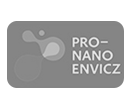Instrumentation of Department of Electrochemistry at Nanoscale
A: Major Equipment for Standard and Advanced Electrochemical Techniques
1) Potentiostats/galvanostats: two EG&G PAR 263A (Princeton Applied Research, USA), AUTOLAB PGSTAT101, PGSTAT12, PGSTAT204, PGSTAT30, three Metrohm AUTOLAB 302N (FRA, ECD, ADC10M, SCAN250), and one potenciostat (CH Instruments, U.S.A.), several Eco-Tribo polarographs (Polarosensors), polarographic analyzers PA3 and PA4 (Laboratorní přístroje, Czech Republic) and three home-made potentiostats.
2) Impedance spectrum analyzers: two-channel network signal analyzer system SR780 (Stanford Research Systems, USA), two FRA modules for EIS measurements (Metrohm, Switzerland), three lock-in amplifiers SR830 (Stanford Research Systems, USA) and single channel lock-in amplifiers
3) Electrode units: two 663VA stand (Metrohm, Switzerland), one rotating disk electrode (Metrohm, Switzerland), several Static Mercury Drop Electrode systems (SMDE, Laboratorní přístroje, Czech Republic), home-made ultramicroelectrodes and insulated STM tips, single crystal gold microelectrodes and home-made amalgam electrode systems.
4) Electrochemical Scanning Probe Microscope: Agilent SPM 5500 (Keysight Technologies, UK), both AFM and STM options, MAC III mode, variable temperature (-5 to 150°C) and controlled-environment option, electric force and Kelvin force microscopy.
5) Scanning Tunneling Microscopy Break Junction System: home-made setup for single molecule conductance measurements and Mechanically-Controllable Break Junction System: home-made setup for single molecule conductance measurements.
6) Four single-nozzle fused deposition modelling 3D printers (Průša, Trilab, Czech Republic), one dual-nozzle (bimaterial) fused deposition modelling 3D printer, one stereolithographic 3D printer (Průša, Czech Republic) and filament blender (Felfil) for synthesis of the composite conductive material
B: Spectrometers for in-situ combination with electrochemistry
1) UV-VIS absorption spectrometers: diode array Agilent 8453, with equipment (cells, electrodes, quartz-fibers) for in-situ spectroelectrochemistry
2) FTIR spectrometer Nicolet iS50 NIR-FTIR with ATR option (Thermo Scientific) with equipment (cells, electrodes) for in-situ spectroelectrochemistry
3) Fluorescence spectrometer FL6500 (Perkin Elmer)
C: Available Methods
1) Electrochemical Methods:
All standard and advanced methods for fundamental research, electroanalysis and electrocatalysis in aqueous as well as in dry, aprotic (organic) media are commonly used, including dc-polarography, linear sweep and cyclic voltammetry, differential pulse polarography and voltammetry, square-wave polarography and voltammetry, bulk electrolysis, coulometry, chronoamperometry, chronocoulometry, chronopotentiometry, AC polarography and voltammetry, electrochemical impedance spectroscopy, fast scan rate voltammetry using ultramicroelectrodes.
For all measurements electrodes of various shape and material are available: mercury, mercury amalgams, platinum, gold, single crystal gold, silver, glassy carbon, graphite, BDDE (Boron-Doped Diamond Electrodes), optically transparent Indium-Tin Oxide (ITO) electrodes, platinum and gold ultramicroelectrodes as well as insulated SPM ultramicroelectrodes for electrochemical scanning probe microscopy.
Studies of electron transfer mechanisms and kinetics, electrochemical transformation of the organic compounds, investigation of intramolecular electron interaction between two or more redox centers, studies of the relationship between structure - redox properties - activity (bio-, photo-, catalytic-, pharmacology-, ...), adsorption studies.
Voltammetric analysis in batch and flow systems - analytical application in electroanalytical sensors, biosensors and flow-through detection.
2) Spectroelectrochemical Methods:
In-situ combination of electrochemistry with UV-VIS-NIR and FTIR spectroscopy in mechanistic studies of the systems undergoing redox transformation in aqueous as well as organic solvents, interception and identification of (radical) intermediates, characterization of products, evaluation of kinetics and stability.
3) Methods for self-assembly characterization at the electrode-electrolyte interface include differential capacitance measurements, STM and AFM imaging under potential control, force measurements and conductance measurements, QCM measurements etc. for electrode modification, mechanistic studies on modified electrodes, sensor development.
4) Methods for charge transport studies in self-assembled monolayers and single molecule junctions include temperature dependent I-V measurements, scanning tunneling spectroscopy, STMBJ and MCBJ for single molecule conductance studies. Applications in electrode modification, mechanistic studies on modified electrodes, single molecule response, molecular electronics.
5) Quantum chemical calculations of HOMO-LUMO energies, electron distribution, optimized geometry, transmission functions, molecular conductance and junction geometries.
D: Additional equipment
1) Water purification system: Milli-Q (Merck, Germany)
2) Quartz crystal microbalance: QCM200 (Stanford Research Systems, USA)
3) Dry box: Labstar 50 (MBraun, Germany)
4) Grinder/Polisher: Metaserv 2000, Buehler (Germany)
5) Inverted Metallurgical microscope: MTM Intraco Micro
6) Rotating vacuum evaporator: Büchi (Germany)
7) Amalgam mixer: Dentomat compact DEGUSSA-HÜLS (Brasil)
8) several pH meters
9) Thermostats
10) UV-lamp (Desaga)
11) Optical microscopes
12) Conductivity meter (Hanna Instruments)

















